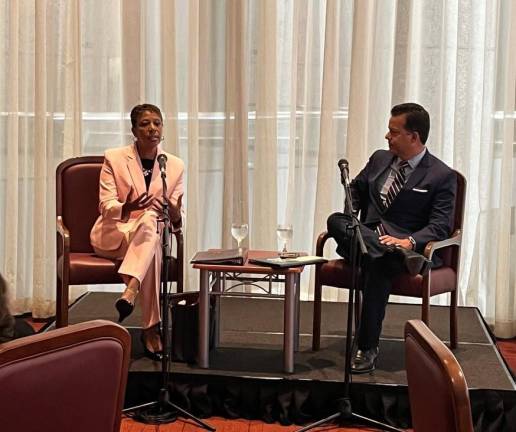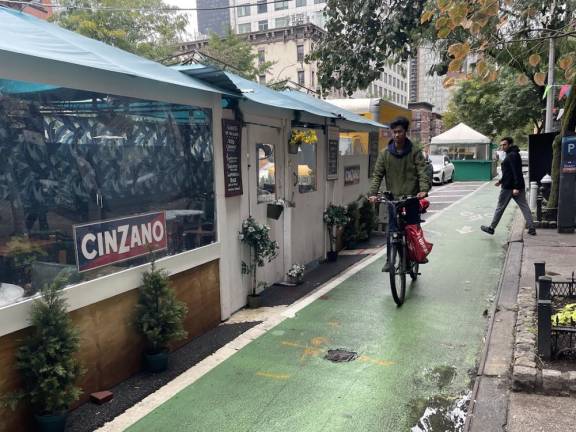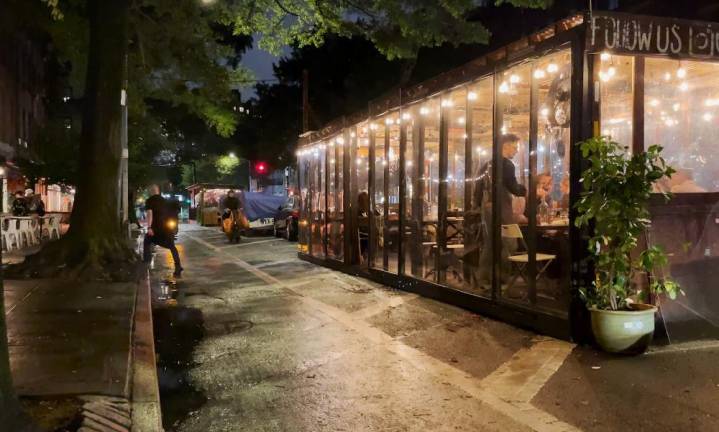Booze and Bike Lanes
Two years into outdoor dining, hundreds of restaurants may be violating state law by serving alcohol in sheds across bike lines



Nothing is ever simple in the Great City. Take the revolution in outdoor dining wrought by the pandemic.
Ok, we still aren’t Paris. But from the occasional sidewalk café, mostly in Manhattan, we leapt to thousands of outdoor eateries on sidewalks and in the street across all five boroughs.
Booking a table for four comes now with so many new choices, beyond something near the dance floor. Would you prefer to sit inside, or on the sidewalk or in that shed across the bike lane?
Ah, there’s a rub.
Because two years into the “temporary” outdoor dining program it turns out that hundreds of restaurants may be violating state law by serving alcohol across bike lines to those dining sheds.
The issue was raised last week by Manhattan Community Board 1, which demanded in a resolution that the city address the matter.
The community board’s chair, Tammy Meltzer, called on the city “to abide by state law and SLA law to ensure the safety and security for the bicyclists, as we attempt to make our city safer, and not allow for sheds in the floating parking lane.” Safety for the servers and patrons, too, she added.
Crossing the Bike Lanes
SLA stands for the State Liquor Authority, which licenses any restaurant that serves liquor. The issue of crossing the bike lanes to serve those dining sheds was at the heart of a meeting Manhattan Community Boards 1, 2 and 3 held with the chair of the SLA, Vincent Bradley.
The meeting was organized by Assembly Member Deborah Glick, who attended with her colleagues State Senator Brian Kavanaugh and Assembly Members Yuh-Line Niou and Harvey Epstein.
Spokesmen for Bradley did not respond to requests for comment. But based on the discussion with the SLA, Lucian Reynolds, District Manager of Community Board One, explained to the community board that state law bars serving alcohol across a vehicle travel lane, and that travel lanes are defined as from one sidewalk curb to the other.
“So bike lanes and vehicular motor lanes would all be considered to be travel lanes,” he explained.
“That represents a technical challenge to the letter of the law that was described by the SLA, where service is not allowed to take place across a travel lane,” Reynolds continued.
“It’s a distinction that demands a lot more discussion and scrutiny. Because it may mean that all the dining establishments that are in the curb lane along those types of streets may be legally disallowed from enjoying alcohol service if there’s outdoor seating.”
This issue arises at a difficult time for proponents who want to continue to use the roadway for permanent outdoor dining. Mayor Adams and the City Council have been haggling over details of a permanent program for months even as a court suit stalls the whole effort.
“Sidewalk Structures”
Then last week, the speaker of the City Council, Adrienne Adams, delivered a surprise statement that outdoor dining should be confined to sidewalks.
“Outdoor dining should be — in my perspective — should be sidewalk structures instead of the structures that we have in the streets now that a lot of them have turned into other things, which they were not meant to be,” Adams said at a breakfast of Citizens Union, the reform group.
“The structures that are in the street, that are taking up bike lanes and parking spaces and other things, that may or may not be popular to some but were never intended to be permanent structures.”
Supporters quickly rallied to the defense of dining in the street.
“Streeteries were initially intended as a temporary solution to save restaurants and jobs during the worst of the pandemic, but due to its popularity, the city is now going through the legislative process to develop a standardized roadway dining program to complement the successful sidewalk cafés that the city’s had for over 45 years,” said Andrew Rigie of the New York City Hospitality Alliance.
“Outdoor dining with streeteries has incredible supporters including Mayor Adams and many City Council members who have planned to enact an enhanced outdoor dining system that will be a successful and an essential feature of the city’s streetscape for many years to come.”
Alfresco NYC, a coalition that supports use of the streets for dining, said that a mere .3% of public parking spaces were taken over by restaurants. The program “demonstrated that New York can use street space usually reserved for private vehicles, in addition to sidewalk space, to better serve businesses and communities.”
Dining in the Roadway
Speaker Adams stressed that she was offering her personal opinion, and an aide rushed in to say that the plan on the table still includes dining in the roadway (although the city says structures will be less permanent and intrusive).
But other critics of the dining sheds were heartened by the speaker’s comments.
“I think what she was saying was extremely well considered,” said Jan Lee, a Chinatown entrepreneur. “This was not a slip of the tongue. This was not something where she just accidently decided to say it.”
Lee is a member of CueUp, a coalition of neighborhood groups and businesses that has been fighting use of streets for outdoor dining. He said the roadway dining program has been fundamentally unfair.
“We are looking at one industry taking over so much at the sacrifice of other people’s small businesses,” he explained. For example, he said a number of Chinatown restaurants had to hack through or work around street sheds for their takeout trade, which depended on customers pulling up to the curb.
Other retailers suffered, too, he said, when walls of sheds blocked pedestrians across the street from viewing their storefronts, their principal form of marketing.
Safety Issues
Worst of all, he said, the debate over sheds in the street was distracting from the larger challenge: many restaurants are closing early because both patrons and staff are afraid to ride the subways home late at night.
“We could spend the next six months talking about dining sheds,” he said. “The subway’s not going to be any safer and workers are going to be dwindling just as much. They’re going to find other cities to go to. They’re going to find other suburbs to work in. They still need to eat. They are going to find other places to work. But it’s not going to be here.”
Cheri Leon, a cofounder of CueUp, said the the city was being impossibly contradictory in its search for a permanent roadway dining plan.
“You’re building something to withstand the elements, to protect the diners inside from any kind of hazard, from cars hitting them or anything,” she said. “So they have to have a certain sturdiness to them. Basically you have to build a building to do that. But you also want them to be temporary and removable.”
The challenge of crossing bike lanes to get to dining sheds has been introduced into the lawsuit that claims the city has improperly extended emergency powers to continue the outdoor dining program.
“The abundance of outdoor sheds on the streets of Manhattan has made my job substantially more dangerous,” Russell Whitehouse, a bike delivery courier, wrote in an affidavit submitted in the case.
“The close proximity of outdoor dining sheds to already narrow bike lanes create dangerous congestions,” Whitehouse said, “wherein waiters and restaurant patrons are constantly crossing over the bike lanes ... this creates a constant threat for both bike lane patrons and restaurant patrons/workers.”
“We could spend the next six months talking about dining sheds. The subway’s not going to be any safer and workers are going to be dwindling just as much.” Chinatown entrepreneur Jan Lee